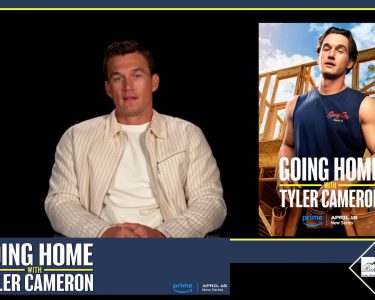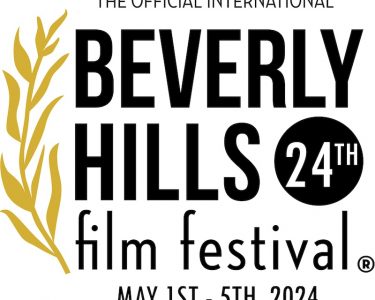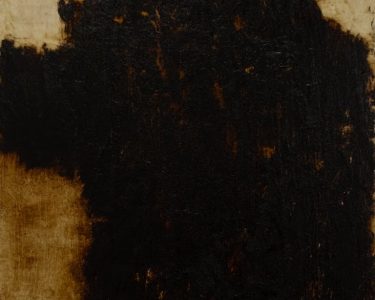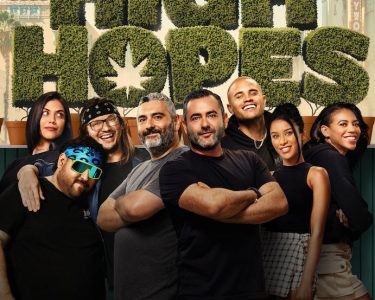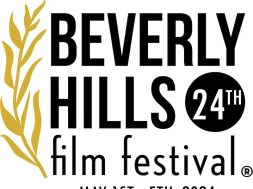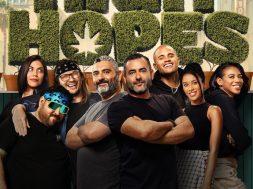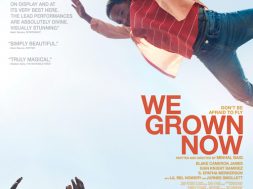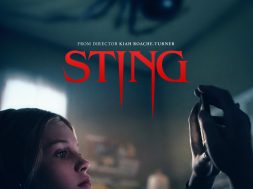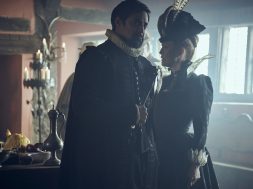The Disapperance Of Eleanor Rigby In Theaters October 10th
When “The Disappearance of Eleanor Rigby” premiered at the Toronto International Film Festival last fall, it was already an intense project for first-time director Ned Benson: two separate films, one subtitled “Him” and the other “Her,” about a relationship fracturing in the wake of a tragedy.
“Him” was told from the perspective of James McAvoy‘s character, “Her” from the perspective of Jessica Chastain‘s; run back-to-back, the two films were stunning, deeply emotional and, possibly unmarketable.
Never having seen either version, ‘The Disappearance of Eleanor Rigby’ was just one film for us. Every one handles loss in their own way and that is what filmmaker Ned Benson has tackled in his latest film ‘The Disappearance of Eleanor Rigby. Actress Jessica Chastian(Eleanor) does a spectacular job portraying a woman who has chosen to handle her loss by committing suicide. Her husband James McAvoy(Conor) tortured by his wife’s attempt and unable to come to terms with his inability to understand his wife decision to leave him. The film explores the couple’s perception of the tragedy which is doled out to the audiences in pieces. If you have the patience to wait this film out, you will still be left wondering about this couple and who they really are. Can they reclaim the love they had before or are they destined to separate futures?
Written and Directed by Ned Benson, Produced by, Cassandra Kulukundis, Ned Benson, Jessica Chastain, Todd Labarowski, Emanuel Michael
The film stars Jessica Chastain, James McAvoy, Nina Arianda, Viola Davis, Bill Hader, Ciarán Hinds, Isabelle Huppert, William Hurt, Jess Weixler, Nikki M. James, Jeremy Shamos
Q&A WITH DIRECTOR/WRITER NED BENSON
& PRODUCING PARTNER CASSANDRA KULUKUNDIS
What inspired you to make THE DISAPPEARANCE OF ELEANOR RIGBY?
Benson: I wanted to explore love in relationships and was really interested in the idea of subjectivity in terms of how two people can experience the same thing in different ways. And on a broader scale, I wanted to play with the idea of subjectivity in terms of how we all experience the same story, how we each experience the same moments or periods of time and ultimately, how different that is. I thought what better way to write a love story than from both sides of the relationship—it just seemed more honest than just capturing one perspective.
When you guys first showed the film at the Toronto Film Festival, it existed as two separate versions called HIM and HER. Can you describe the process of putting them together into the most recent combined version?
Benson: Whether these films could be combined was a hanging question, so we took the opportunity to try it and were all more than pleasantly surprised with the result, especially after submitting it to Cannes and getting in, which is just crazy to me. I worked with the same creative team I edited HIM and HER with, and we basically dropped into an editing bunker to find this movie. The biggest challenges we faced were that this third film had to be its own entity with its own rhythm, themes, and ideas, which meant that scenes that functioned or played in the other two films didn’t necessarily work or play in this one. We had to focus the film on the couple, Eleanor and Conor, and the mystery of what happened to them, rather than each of their disparate perspectives and the themes that came with those. This film becomes a visual dialog between them, rather than just their subjective experience. It becomes more omnipotent. I got to use footage shot during production that we didn’t use in the others. It was an incredible editorial experience, which in this wonderful way taught me a lot about filmmaking.
Tell us about the experience of making what is your first full-length feature film?
Benson: This has been the most creatively overwhelming experience I’ve had in my life, in the best possible way. From the earliest of days, it was such an amazing collaboration with a wonderful group of people working to make this film come together. I’ve tried many times to make other films that just didn’t come together—and for some reason, what in all logic seemed to be the most difficult to get made, was actually the first one to happen. You only get to make your first film once—and this has all been pretty incredible.
Kulukundis: Working with Ned on this project has been such a great experience. Not only because he is one of the most talented writers and can edit things in 10 seconds when need be, but he’s creative and understanding of the process of putting a film together. There’d be moments where I’d say something like—“Hey, I know you love that song, but we can’t afford the rights to it.” And he’d just look at me un-phased and be confident that we’d find another one that would work even better. And that’s the attitude you need to come to the table with when you’re making an independent film. This entire filmmaking process, we’ve approached it as partners who are 100% invested in everything.
Jessica Chastain was on board early on—how did she become involved to begin with?
Benson: I met Jes about 11 years ago now. I had a short film playing in a film festival, and there were something like 12 people in the audience. Afterwards this girl comes running up to me in the lobby and asks me if I directed the film she just saw. I said yes. And she said: I want to work with you. And I thought to myself: Why? The girl happened to be Jessica, who had just graduated from Juilliard and moved to LA to be an actor. She was my first fan and has believed in me for a long time, which I am extremely grateful for, because without that I’m not sure I’d have made this project. We became very close and I developed what became the two-film project with and for her…and here we are. Life is funny.
Furthermore, tell us how the rest of the incredible cast became part of the film.
Benson: Once we had Jessica involved, I knew I wanted James McAvoy to play the role of Conor. Because of his scheduling, we actually didn’t have James locked in until a few months before we started shooting. Having Jessica and James was sort of an amazing coup for me. The first to get involved after Jessica was William Hurt. He signed on a year before we started filming and was a big proponent of the script. And from there this amazing thing happened where everyone who we reached out to as my first choice began saying yes. It felt like all of a sudden the film came together and I’m directing this incredible cast of Jessica, James, William, Viola Davis, Isabelle Huppert, Ciarán Hinds, Bill Hader, Jess Weixler, and Nina Arianda.
Kulukundis: I actually come from a long line of casting, so that was helpful for us. Behind the scenes as the script got to a really good place, I was calling and getting people to read it. The strength of the script made it its own calling card and got us all of the right people. Like Ned said, it took almost two years to get James attached because of his schedule. But as soon as he did we jumped in and went right into production. Ciarán happened to be on the East Coast working so I popped the script over to him—we’d worked together on There Will Be Blood. I approached Viola’s team very early on and they couldn’t have been more supportive and we got her to sign on. And of course Jessica was there from the development and has been a part of our team. And like that, everything came together piecemeal.
After many years developing the script, what was it like to finally get behind the lens?
Benson: I’d envisioned this film for so long. I created this whole workbook of ideas of what I wanted it to feel and look like down to the moods I wanted to set in every scene. I’d pretty much shaped the entire world of the film out of my imagination. And so to actually begin directing and working with our production designer and location manager to refine these spaces or sit down with the DP to go through our ideas and actually develop the look was an incredible experience. Having what I’d ideated for years become a reality made me appreciate that I get to do what I love for a living.
How did the film’s title come about?
Benson: I had been looking at the song before I began writing the script. And listening to it, there was a mood, a feeling to that song and to the characters—especially with the line “All the lonely people, where do they all come from.” From there I began thinking of this collective of people who experience their own loneliness and I wrote that line in a notebook. It became something that helped me create the proper emotional space for me to write. Then I thought why not name the character after that and create this moment behind her name. Cassandra knows from working together that I love this idea of the disconnect between the baby boomer generation and my generation. And so I wanted to use the Beatles as just this abstract reference in the film where Eleanor’s parents name their daughter after this infamous song and it sort of bridges the two generations.
Kulukundis: And if you take what happens in the film, Eleanor just disappears. She’s disappeared from Conor’s life, from the person he knew and he’s trying to find her. So it kind of captured that feeling.
In your own words, what is THE DISAPPEARANCE OF ELEANOR RIGBY about?
Benson: It’s a film about love and how life is a subjective experience. We all sort of live this one story, but everyone else who is a part of our lives has their own subtly or vastly different perspective of it. What I wanted to explore most was a love story about two people, Conor and Eleanor, who are really trying to figure out how to understand each other after going through something difficult. So it’s essentially a story about the endurance of love, empathy, understanding and perspective.
As Conor and Eleanor, James and Jessica had a real on-screen chemistry. Tell us about that.
Kulukundis: The key to their chemistry was the collaboration they had behind the scenes. In a lot of ways they had a different approach to their work, but they just really connected in what they wanted to bring to the film. And because of that they made a great team.
Benson: Their different methods actually played into the differences in terms of the characters, in how Conor and Eleanor dealt with things in their own way. I’m really proud of the performances they gave. As actors they did such beautiful work.
What was it like working with Jessica Chastain on the film?
Benson: It was fantastic. She’s the type of actor that when you have a tough emotional scene, you have complete trust in her because she’s going to get there. She’s one of the hardest-working actors I know. She just has this emotional depth that is so incredible to watch when you’re shooting her, or when you’re working on a scene with her because she can do it over, and over, and over again. And to have a film as emotional as this and have somebody who can get where she got in every take, and give you options—it’s a pretty amazing thing.
Kulukundis: Jessica’s role comes out of her. You don’t see gears turning or feel she’s working. It’s coming from the inside out. And what I love about this film is that there’s such levity there for her too in flashbacks running around in love and being playful with James. She just embodied this happy youthfulness that she has, but hasn’t really gotten to show on film yet.
What was it like working with James McAvoy on the film?
Benson: He’s a dream. He’s hilarious and silly and charming, but he’s also a searcher. He works really hard and wants to find the scene and will constantly push through each take to sort of ask a lot of questions. He really wanted to get to the epicenter of what the scene was about. For me he was the guy that could make me feel relaxed at all times because he was so relaxed.
Kulukundis: James commits and nothing else exists. He is Conor and there’s nothing else that is going to get in his way. It was such an honor and blessing to have him. He was 100% available. And the best part is that the moment you’d call cut, he’d be back to his own accent and personality. The moment Ned yelled action, James and his accent both disappear.
You have an extraordinary supporting cast. Tell us about working with them.
Benson: I may have been a little spoiled to work with this incredible cast. In terms of William, Viola and Isabelle—they’re like three teachers. I learned so much from each of them. They’re each so accomplished. These are people I look up to and I really wanted to create an atmosphere for them that would allow them to do their best. William and Isabelle actually both spend a lot of time in France, so they had a really nice relationship on set. They even improvised this one scene in French that actually helped it come alive. And what can I say about Viola Davis—she’s amazing.
Kulukundis: Viola, I want to say this in the best way, is like a machine. She is just so powerful. Every take, everything is different. She was actually on set very briefly, but she just delivered. And because it was Viola, it felt like her scenes were its own beautiful movie. We both would love to work with her again.
Benson: And the other supporting roles, these actors are so incredibly talented. We had quite a few Tony winners and nominees. It was a really strong theater group. Nikki James won a TONY® for The Book of Mormon, Nina Arianda won a TONY® for Venus in Fur, and both Katherine Waterston and Jess Weixler have done a lot of theatre in New York. Ciarán Hinds is also an amazing stage actor, and the friend I never had. He’s such a lovely man and beautiful actor. He’s so subtle in everything that he does.
Kulukundis: It was great seeing Bill Hader take on a different type of role. He did a step here. I mean, it’s Bill Hader so there’s still that charming goofballness, but there are moments that really allowed him to shine in his role as a great friend genuinely trying to help.
Benson: It was a dream cast. And they all were just so different, but so wonderful, each of them, and each of their processes. That was amazing in itself, to see all of these actors working in different ways and how they came together and collaborated.
At the heart of the film is a couple trying to reclaim the relationship and love they once had. Talk about how they seemed to come at it from different angles.
Benson: I think if I were to sum up the dynamic it would be that Eleanor is trying to let go and Conor is trying to chase her. And in a weird way, you see that at the end; Conor has realized that to understand what Eleanor needs, he has to let go. Similarly, for Eleanor, you see that in the process of letting go she’s been brought back to the moment where she’s ready to come back to him. So in terms of an active verb, I’d say Conor is running after her and Eleanor is running away from him. But at the end of the day they’re both moving towards finding their own way to move forward into their future together.
There is a line that Eleanor says, “It’s like we’re a million miles away in the same room.” Can you elaborate on what she’s feeling?
Benson: As a couple they’re under an enormous weight of this personal tragedy and even though it’s not directly unfolding on screen, you can feel that they are dealing with it in different ways. They just don’t know how to communicate anymore. And because of all of that, they seem to be speaking different languages which then causes them to feel like strangers to each other. I’d say they’re looking at each other like who is this person and why are you behaving this way over the exact same thing that happened to me?
Kulukundis: I think in general they feel like they’re completely alone, even when there are surrounded by people. When they are with each other there should be a shared understanding, but because they are dealing with things so differently it is as if the other person doesn’t really see you. And they don’t exist to you either, because you’re not emoting in the same place. That’s how you can become strangers with someone you love.
Benson: Eventually these two people get to a place where they understand why they each dealt with everything in a separate way. The truth is we all deal with things differently—that’s part of who we are and it’s something we have to accept in order to love each other.
Though we learn a tragedy has taken place in their lives, it is never shown on screen. Tell us about making that decision.
Benson: That was a really important decision because this was a film about this couple’s love—and less about the tragedy. I was interested in exploring their behavior around that tragedy and its effect on the relationship itself. Eleanor says this line, “I wasn’t ready for what this feels like” at the end. It’s sort of the ultimate description of their experience. They both weren’t prepared to confront that feeling and what it did to them. And so I think the relationship and what life can do to us was significantly more important in telling their story than the actual tragedy.
Kulukundis: Just about every relationship begins bright and happy until eventually something happens. The buzz wears off of the relationship and then it feels like there’s a metaphoric death. And you have to decide is there enough foundation there to come together and continue on as a couple, or does it affect the relationship so much that you have to free it forever.
There is a moment in the film where Eleanor is speaking to her father and he is desperately trying to connect with her. He says “Tragedy is a foreign country—we don’t know how to talk to the natives.” Tell us about what he means.
Kulukundis: Well often, when there is a tragedy, there’s nothing you can say that ever makes anyone feel better. Because no matter what, everything IS wrong in that scenario and although you want to help them, you can’t. To have that powerlessness as a parent has to be the most frustrating thing. And it’s a fundamental struggle between all of these people in that they want to help, but they’re not necessarily fully equipped to.
Benson: I think every character is struggling against the fact that there’s nothing that changes the circumstance. It’s a feeling that these two people have to go through and there are no right words that can make this better or solve it.
What is the relationship like between Conor and his father?
Benson: I think the relationship between Conor and his father is a man looking at his son and seeing himself. And it’s a son trying to pave his own way. Conor’s reluctance in taking his father’s hand, who has sort of reached out to help him, is Conor trying his hardest to be an individual and not exist in the shadow of his father. Emotionally, I think they are very similar and I think they’re both terrified of that and trying to reconcile it.
What is the relationship between Eleanor and her parents like?
Benson: Eleanor has a difficult relationship with her mother, who I think is still coming to terms with the life that she gave up in order to be a mom. And in that light, she almost resents and hates seeing her daughter go through something so difficult, because she too is feeling her pain. There’s a scene where Eleanor’s mother says to her, “I never wanted to be a mother.” And that can be interpreted in so many different ways, but I wrote it as if she’s almost dreading the fact that her daughter is suffering this much, because she doesn’t want her daughter to hurt in this way. She’s in a weird way, trying to push her daughter from becoming what she became, which is sort of this woman who struggles with herself and gave up things. I think she’s pushing Eleanor to run off and escape. With Eleanor’s father, there’s a communication barrier where they aren’t able to articulate their love to each other, but there’s an understanding deep underneath. And because he’s a psychiatrist and teacher, he has this pedantic side to him that’s trying to help her but she’s not open to it. So the only thing he can do is tell a story about how he felt when he lost her in the ocean, and what that was like for him. It’s his way of letting her understand that he knows what she’s feeling.
Also struggling to reach the couple are their friends, particularly Conor’s best friend, Stewart. Tell us about that dynamic.
Benson: At one point Stewart looks at Conor and says, “I don’t know how to be your friend anymore.” And that kind of said it all. He’s essentially telling Conor that he doesn’t know what to say because he’s afraid of setting him off, of not being delicate enough or dwelling on it too much. He’s trying to allow Conor to be the person he is, but he’s watching his friend struggle and it’s having an effect on their friendship. He’s trying to be the best possible friend for him, but also wants Conor to be a friend to him. For them, it came down to not the words that were said, but the shared moments where they could look at each other and understand.
Viola Davis’ character becomes a friend to Eleanor. And in the film, her character is the only one who has no knowledge of the tragedy the couple is reeling from or what is happening between Conor and Eleanor. Tell us about her character.
Benson: She’s the only person in the film who has no idea what Eleanor’s been through. And Eleanor wants it that way because everybody in her life knows exactly what happened and treats her accordingly. I think Viola’s character recognizes something, maybe a similarity within herself, whether it’s the sadness, loneliness or struggle, which she projects onto Eleanor. Whatever it is, there is recognition between these two people and they have a shared feeling between them, which becomes a bond.
There is a scene close to the end where Conor and Eleanor truly connect and have an understanding of each other. Can you discuss that scene?
Benson: In this scene Eleanor’s returned to their apartment. She and Conor both break down together. It’s the first time you see Conor and Eleanor actually understand each other and speak the same language since they’ve been apart.
Kulukundis: What I liked too about this scene was that leading up to it you see another scene where Eleanor goes to Conor in what is an attempt to start connecting. And as they’re driving in the rain and in the car, they are both trying so hard to recapture something but they can’t. They’re not ready to move on. And I think that’s what’s so great about the last scene—they need to have the breakdown before they can actually rebuild.
What was the rehearsal process for the film?
Benson: We didn’t have a lot of time, about a week or week and a half. And because of their schedules, not all of the actors were able to come in that early. But we had about a week with Jessica, James, William, Jess, and Ciaran. It was a great experience working through the script and hearing the dialogue coming from these actors. We worked on their characters and talked a lot about their world to help discover who these people were. It was amazing for me, especially working with William Hurt who is a meticulous actor. I learned so much from him in those days leading up to the shoot just in terms of talking with him.
Was there any room for improvisation from the actors?
Benson: Yes. We mostly stuck to the script, but I wanted to give them the freedom to try something. I usually gave the first take to the actors, and if we had to make adjustments, we’d move elsewhere. Ciaran and Isabelle especially would tailor it more to who they were as an Irish man and a French woman so that some of the script felt more organic coming out of their mouths. But we’d do the same for all of the actors. We wanted everything to feel natural and real to them. I think we all just sort of used the blueprint of the story and went from there.
Tell us about the experience of shooting in New York.
Benson: It was a dream because Cassandra and I are both from New York. The extras are almost built-in. There are so many shots that we filmed where people are just riding bikes, walking by not interested in the camera. You really feel the city and we created what is our version of New York.
Kulukundis: Most of it was shot in the East Village which is in a transitory stage right now. And that was great because it kind of reflects where Conor and Eleanor are in their relationship. You’ll see a lot of construction and it’s like a little metaphor for the characters trying to transition themselves through something. Shooting in New York really gave the film the right energy.
I heard there was a serendipitous event that occurred when you were filming the scene in Tompkins Square Park. Tell us about that.
Benson: We had the scene at the park and usually there aren’t fireflies in the middle of the East Village in New York City, but on that one night we were shooting, the fireflies hatched and there were thousands of them. It was such a crazy night because it only happens once a year. We weren’t aiming to hit that night, it just happened which is pretty close to impossible. Filming that scene and having these fireflies actually come up from the ground in Tompkins Square Park was beyond belief because the fireflies were actually one of the first ideas, one of the first images I had writing the script. So having these fireflies really appear was pretty magical.
Tell us about the song choices for the film.
Benson: Well, music is such a huge element to my life in general. I wrote the script listening to music, the title was inspired by the Beatles’ song, I gave playlists to the actors that I thought were relevant to their characters, and we even shot certain scenes based on the rhythm and mood of certain songs.
In terms of choosing music for the film, I wanted music that reflected the characters and the story rather than just my personal tastes. We have a lot of source cues that play diagetically in the scenes that reflect who these people are and their tastes, but I think the most exciting thing for me was working on the score with the composer Son Lux aka Ryan Lott. Ryan and his collaborators made instruments for the film, and he had the beautiful idea after watching an early cut to use objects that exist within the space of the scenes and create instruments based on them so they feel germane to the story. So, for example, from the early scene of Eleanor and Conor at a dinner table on one of the first nights of their relationship, Ryan had the idea to make an instrument out of wine glasses which were on the table in front of them when they are in that happy moment. That instrument becomes one of the recurring motifs in the score and the songs that Ryan wrote for the film. He wrote a bunch of sketches and then I’d give notes, and he reworked them into the emotional texture of the scenes. That was a very cool process and he and Faux Fix and his collaborators did such a beautiful job. Most importantly, I wanted the music to reflect and feel ingrained in the world of the story rather than placed on it.
Talk about the design of the film and how it helped create the particular mood and emotions you were trying to convey.
Benson: I wanted to create two completely separate visual spaces or looks for Conor and Eleanor. They each have their own color palette and their own visual rhythm for similar specific reasons that were germane to the characters and their personalities. Conor has a cooler more fluid feel, while Eleanor has a warmer looser feel except when they meet in the same scene, all of which I worked on with Chris Blauvelt, the DP, Kelly McGehee, the production designer, and Stacey Battat, the costume designer. In the two separate perspective films I wanted them to remain in their own respective spaces as those films were more subjective to Eleanor or Conor. In this third film, I start them in their disparate color and visual spaces, and ultimately want them to find synthesis and understanding in a blending of those visual ideas. Every creative choice in terms of design reflects the characters, their emotional spaces, and the story.
What would you like audiences to take away from the film?
Benson: I want them to have their own subjective experience with it and see what they want to see in it. I think that’s the beauty of movies: that we each have a personal experience with them and they reflect or articulate certain things that we recognize in ourselves. This is a story about two people who love each other, but they don’t know how to do it right. They have shared a lot of life together and every emotion that there is to share. Ultimately, I think Eleanor and Conor can represent any couple, straight, gay, together, broken up, because to me the beauty of any relationship is that you find your own private language together based on the life you share with each other and the experiences you go through, good or bad. And only the two people in the relationship can really understand the relationship and speak that language. When you go through something like Conor and Eleanor have, everyone can say what they want to say and try to empathize, but nobody can really understand what they went through, except the two of them cause they lived it together. Sometimes it takes a long time to realize that after things become difficult. We are all very different people, with different ways of coping, with different ways of seeing life, but we want to love, and how do we do that right? I hope audiences will recognize or perhaps see themselves and their own relationships in these characters and this story.

